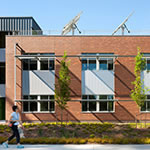Building the highest-rated LEED-certified structure in the Western Hemisphere would not have been possible without unwavering teamwork and an absolute determination to stay on budget. Cebula Hall at Saint Martin’s University in Lacey, Washington, received 97 out of 110 possible points under LEED-NC v2009, and yet construction costs were just $225 per square foot, far lower than many non-LEED buildings being built on college campuses today. “Coming in at cost was a challenge,” says Zella Kahn-Jetter, dean of the Hal and Inge Marcus School of Engineering at Saint Martin’s. “There was a lot of back and forth between the architects, engineers, contractors, and us on how to do things.” How did they do it? We took a tour of Cebula Hall to find out.

Young design students learn a lesson in recycled materials just from sitting in their chairs, each of which is made from more than a hundred Coca-Cola bottles.
A Multipurpose Quad
An academic quad, which provides open space for student activity and recreation, houses 41,000 feet of geothermal heating loops. Above, a rain garden retains storm-water runoff, reduces the need for forced irrigation, and replenishes local groundwater supplies with the rain that comes off the building’s green roof. Overall, the natural and drought-tolerant landscaping reduces the use of potable water for irrigation by 87 percent.
A Sustainable Laboratory
Cebula Hall is designed to serve as an interactive laboratory for student learning. Building components are exposed and labeled, so students can see what they look like. The second floor boasts a deck with two solar panels that trace the sun, and more than 3,000 square feet of solar panels grace the third floor. “It’s a rooftop lab,” Kahn-Jetter says. “The students do experiments on it.” There are also large computer monitors in the main hallways that show how much energy is being saved and consumed and which systems are currently using the most energy.

From its planted roof, which absorbs stormwater and helps insulate the building, to the geothermal wells buried beneath the quad, Cebula Hall is a model of sustainable strategies.
Innovative Materials
An office cluster houses the administration office, the dean’s office, and faculty offices for seven staff members. Each office has large windows to allow as much natural light as possible, as well as daylight sensors to maximize energy efficiency. Windows throughout the building are made from recycled aluminum, and wood elements are made from a mix of recycled and FSC-certified wood. The chairs in each office are manufactured from recycled Coca-Cola bottles.
Eco-Friendly Fixtures
Cebula Hall uses roughly half of the water of a comparable building. Low-flow fixtures reduce water use in restrooms, with the urinals being 88 percent more efficient than standard one-gallon-per-flush fixtures. Dual-flush toilets provide partial flushes for liquid waste, and air dryers eliminate the need for paper towels.

Lessons about energy efficiency can be aided by the large monitors found in common areas, which track energy use and other metrics in real time.
Communication, Collaboration
Communication made this project a success, says Alan Tyler, Saint Martin’s director of facilities and capital projects. “It was a collaboration between me as the owner’s representative, the contractor, and the architect,” Tyler says. “We all worked on the project simultaneously.” This approach enabled team members to identify value-engineering opportunities along with method-and-means savings. “We also avoided potential project construction conflicts early on,” he says. All subcontractors, too, were design-build contractors who both designed and installed systems and could guarantee performance.
Experiential Education
The green roof, along with a white roofing membrane, creates a high-albedo surface that reduces the heat island effect. The solar panels on the patio are computer-controlled so that students can try their hands at programming the systems while getting some hands-on experience with solar power technology. “A part of Saint Martin’s Benedictine core values is to be a steward of the environment,” Kahn-Jetter says. “We’re graduating students who will have seen firsthand that projects like this can get done. That has to be part of their psyche.”

